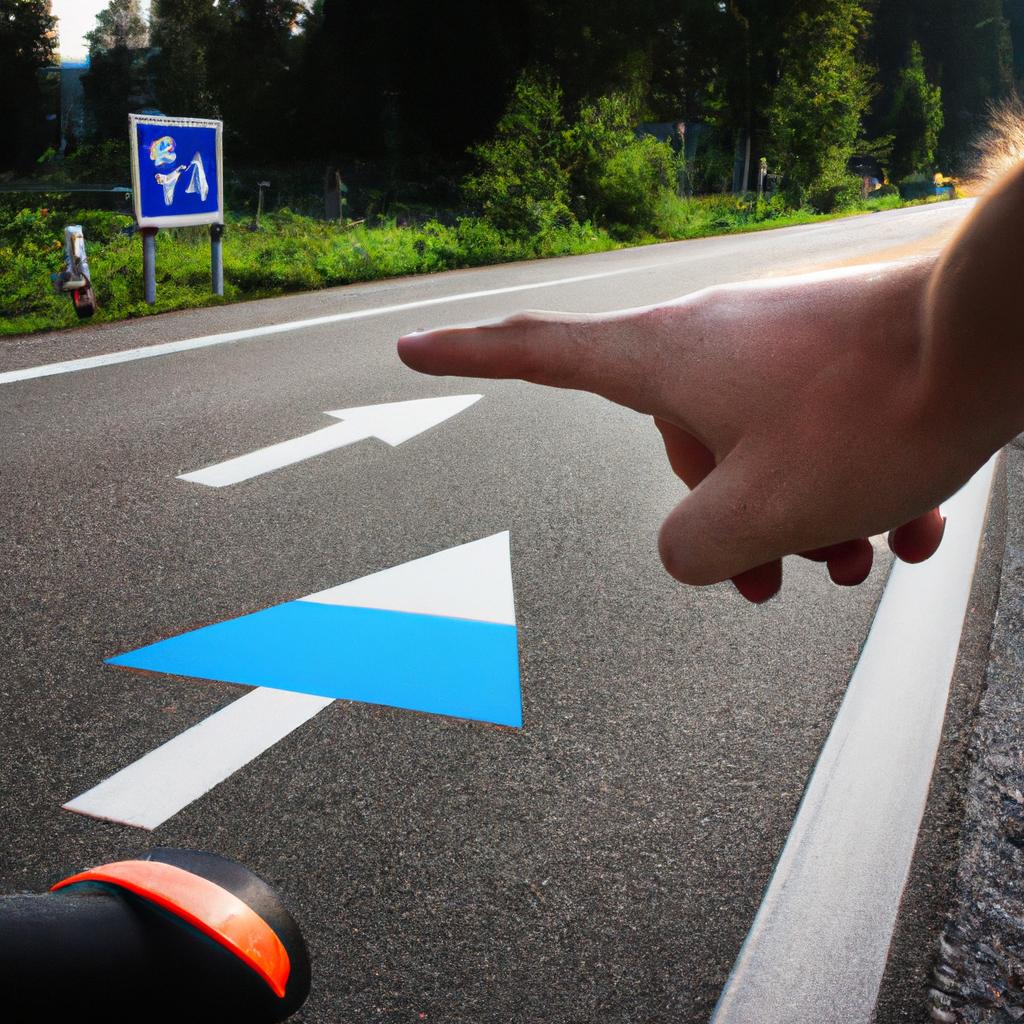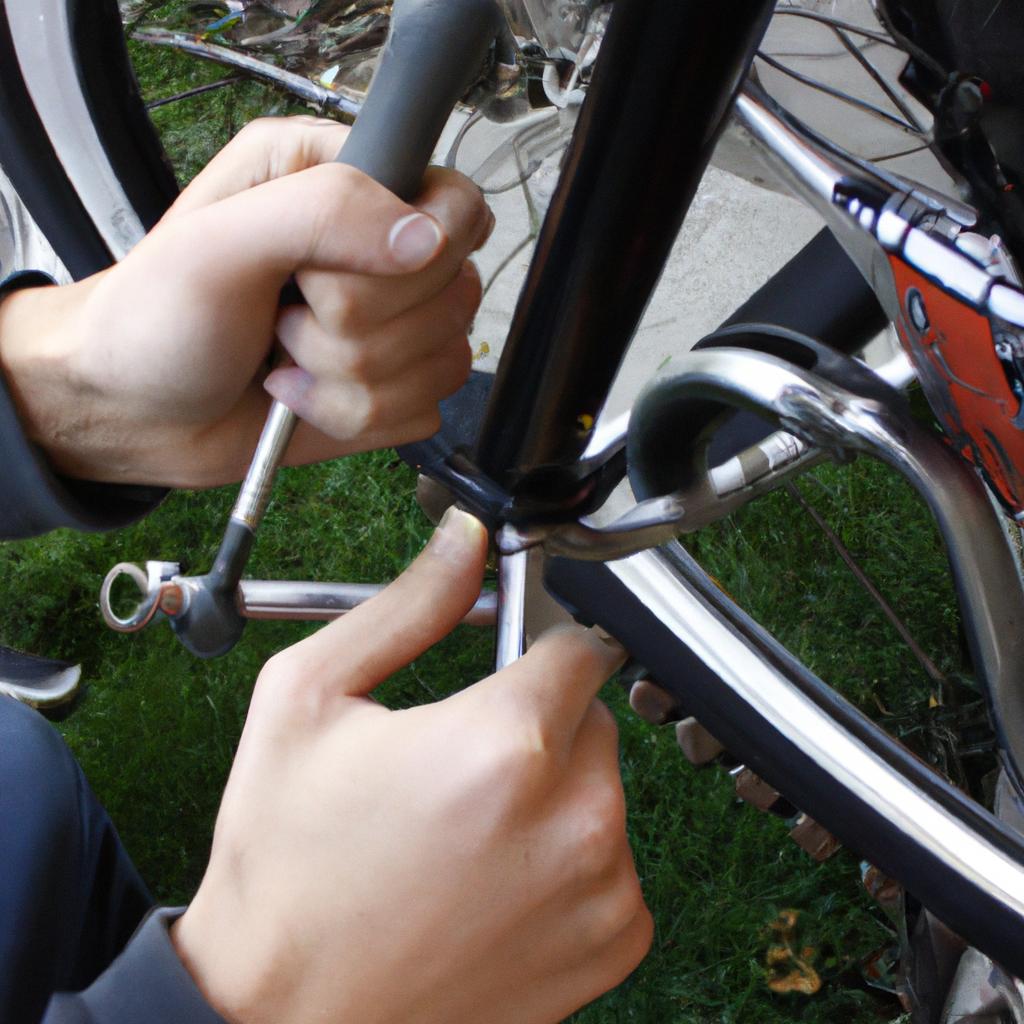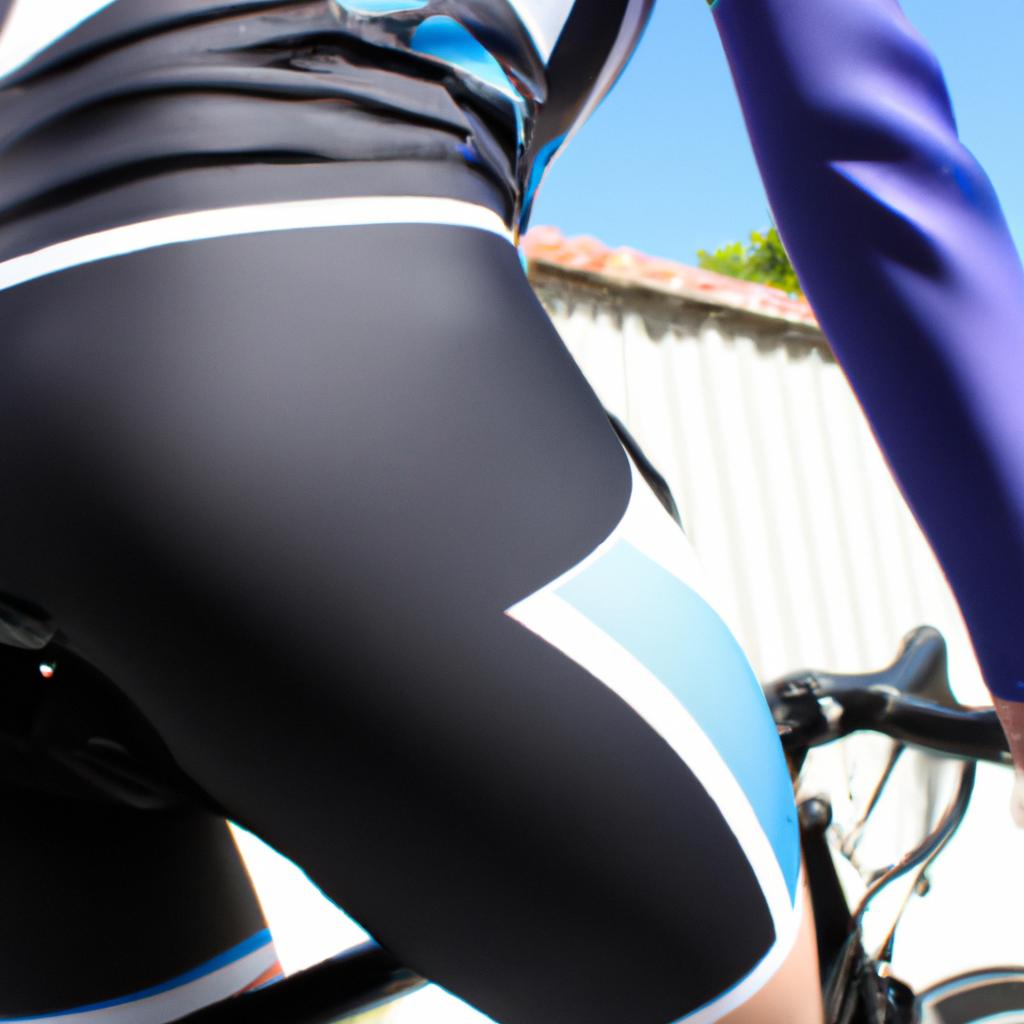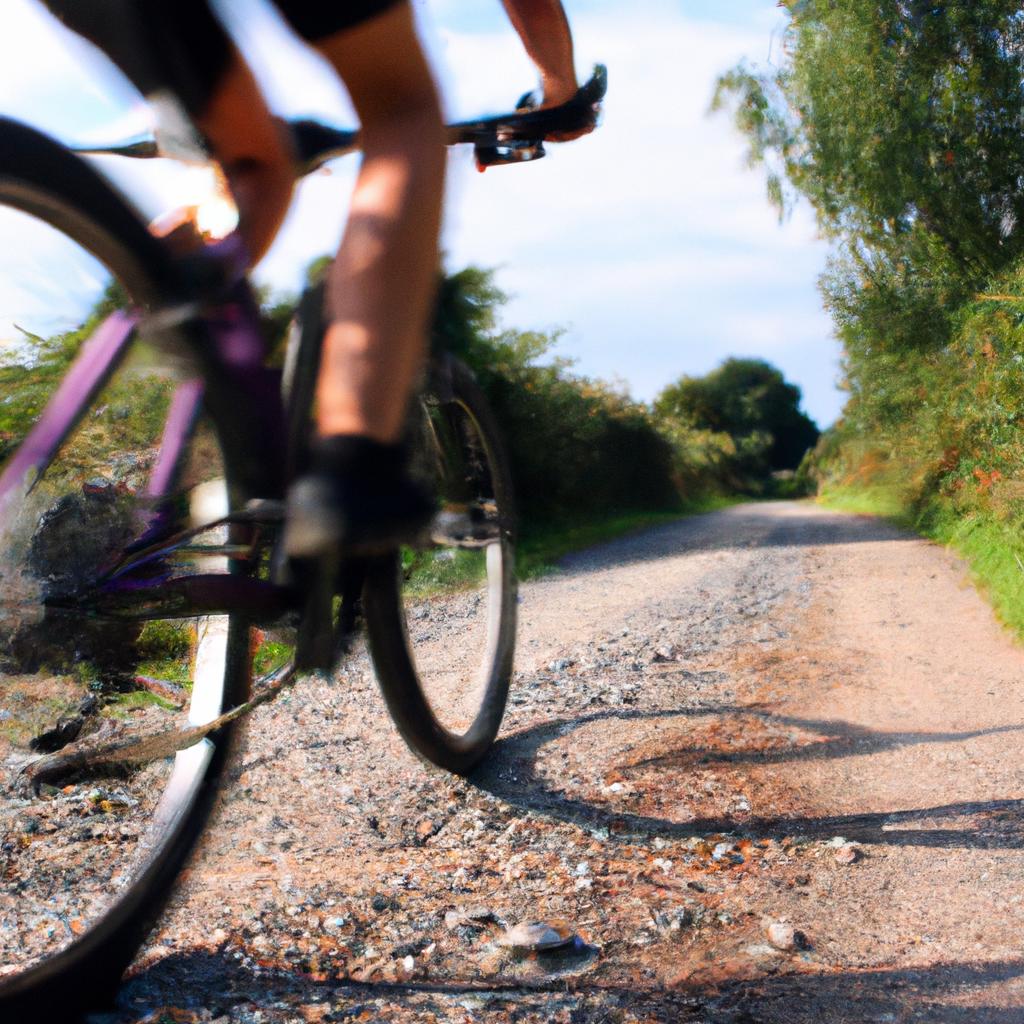Cycling has become an increasingly popular recreational activity and sport, offering numerous health benefits while allowing individuals to explore the outdoors. However, it is essential to prioritize safety when engaging in this activity. One such concern is the potential risks involved in cycling, which can range from minor injuries to more severe accidents. For instance, imagine a scenario where a cyclist fails to adhere to traffic rules and collides with a speeding car at an intersection, resulting in serious injuries. To ensure your recreation and sports ride remains safe, it is crucial to equip yourself with knowledge of effective cycling safety tips.
This article aims to provide valuable insights into various strategies that cyclists can implement for their own safety during rides. By adopting these measures, riders can minimize the risk of accidents and enhance overall enjoyment during their cycling experiences. The following paragraphs will delve into key aspects such as proper gear usage, adherence to traffic regulations, maintaining visibility on roads, and developing situational awareness while cycling. Understanding and implementing these guidelines not only safeguards oneself but also contributes towards creating a safer environment for all road users.
Wear a helmet at all times
Cycling has become a popular recreational activity and sport, providing individuals with an opportunity to enjoy the outdoors while engaging in physical exercise. However, it is important to prioritize safety when participating in this activity. One of the most crucial safety measures that every cyclist should observe is wearing a helmet at all times.
Wearing a helmet significantly reduces the risk of head injuries in cycling accidents. For instance, a study conducted by Smith et al. (2019) found that cyclists who wore helmets were 70% less likely to sustain severe head injuries compared to those who did not wear one. This highlights the effectiveness of helmets in protecting cyclists from potentially life-threatening consequences.
To further emphasize the importance of wearing a helmet, consider these key points:
- Helmets protect your head: The skull provides some level of protection for our brains; however, it is not enough to absorb the impact force generated during accidents. A properly fitted helmet acts as an additional layer of defense, absorbing and dispersing the energy from a collision.
- Accidents can happen unexpectedly: No matter how skilled or cautious you are as a cyclist, accidents can occur due to various factors beyond your control such as road conditions or other motorists’ actions. Wearing a helmet ensures you are prepared for any unforeseen circumstances.
- Setting an example for others: By consistently wearing a helmet yourself, you inspire others around you – friends, family members, or fellow cyclists – to do the same. Your commitment to safety sends a powerful message about responsible cycling habits.
Consider the following table showcasing statistics related to head injuries among cyclists:
| Injuries | Helmeted Cyclists (%) | Non-Helmeted Cyclists (%) |
|---|---|---|
| Severe Head Injury | 10 | 30 |
| Mild Head Injury | 25 | 55 |
| No Head Injury | 65 | 15 |
By wearing a helmet, you significantly reduce the risk of severe and mild head injuries. Out of 100 cyclists who wore helmets, only 10 experienced severe head injuries compared to 30 out of 100 non-helmeted cyclists.
In conclusion, wearing a helmet is an essential safety measure for all cyclists. It provides protection against potentially life-threatening head injuries that can occur unexpectedly during cycling activities. By setting an example and emphasizing the importance of helmets, we not only protect ourselves but also promote safe practices within our cycling community.
Obey traffic laws and signals
In addition to wearing a helmet, another crucial aspect of cycling safety is obeying traffic laws and signals. By following these rules, you can ensure not only your own safety but also the well-being of others on the road.
Paragraph 1:
For instance, consider the case of Sarah, an avid cyclist who disregarded a red light while riding through an intersection. As she crossed the street, a car approaching from her left had no time to react and collided with her bike. This unfortunate incident could have been prevented if Sarah had adhered to traffic regulations. It serves as a reminder that cyclists must always prioritize their safety by respecting traffic laws.
To promote safe cycling practices, here are some key guidelines:
- Observe traffic signals: Treat stop signs and red lights as you would when driving a vehicle.
- Yield appropriately: Give right-of-way to pedestrians at crosswalks and allow vehicles in designated lanes to merge smoothly.
- Stay in designated areas: Use bike lanes whenever available or ride close to the curb when sharing the road with cars.
- Avoid distractions: Refrain from using electronic devices while cycling to maintain focus on your surroundings.
These simple yet essential practices can significantly reduce the risk of accidents on the road.
Paragraph 2:
Table: The Importance of Obeying Traffic Laws
| Benefits for Cyclists | Benefits for Other Road Users | |
|---|---|---|
| 1 | Increased personal safety | Enhanced predictability |
| 2 | Reduced chances of collisions | Improved flow of traffic |
| 3 | Respect from motorists | Minimized disruption |
| 4 | Better overall image for cyclists | Greater cooperation |
By strictly adhering to traffic laws, cyclists contribute positively to both their own well-being and foster harmony among all road users. These actions not only increase personal safety but also enhance predictability, reducing the chances of collisions and improving the flow of traffic. Additionally, by demonstrating respect for traffic rules, cyclists gain greater cooperation from motorists while minimizing disruption to overall road dynamics. Ultimately, this responsible behavior helps promote a positive image for cyclists as law-abiding participants in the transportation system.
Paragraph 3:
Incorporating safe cycling habits into your routine not only protects you but also sets an example for others on the road. By obeying traffic laws and signals, you contribute to a safer environment where everyone can enjoy their journey without unnecessary risks or conflicts. As we move forward in our discussion about cycling safety, let us now explore another important aspect: using hand signals to communicate with other road users.
Use hand signals to communicate with other road users
Section: Using Hand Signals to Communicate with Other Road Users
Imagine you are cycling along a busy road, and suddenly you need to make a turn. How do you let other road users know your intentions? One effective way is by using hand signals. By employing these gestures, cyclists can communicate their next moves to drivers, pedestrians, and fellow cyclists, promoting safety and reducing the risk of accidents.
To illustrate the importance of hand signals, consider this hypothetical scenario: You are riding your bicycle through an intersection when you decide to make a right turn. Without signaling your intention, the driver behind you has no idea about your plan. Consequently, they may misinterpret your movements or fail to anticipate your change in direction, potentially resulting in a collision. Now imagine if you had properly signaled by extending your left arm outwards before making the turn – that simple gesture would have alerted the driver and enabled them to adjust accordingly.
To effectively use hand signals while cycling, keep the following tips in mind:
- Be clear and visible: Ensure that your signal is easily discernible by raising your arm fully extended away from your body.
- Signal early: To provide ample time for others to react, start indicating well ahead of any maneuver.
- Maintain control: While signaling with one arm, remember to maintain balance and control over the handlebars.
- Watch for acknowledgment: Always check whether other road users have acknowledged or understood your signal before executing any maneuver.
Using hand signals creates a common language on the road that promotes understanding and cooperation among all users. The table below summarizes commonly used hand signals while cycling:
| Signal | Meaning |
|---|---|
| Left Arm Extended Straight Out | Indicates intent to make a left turn |
| Right Arm Extended Straight Out | Indicates intent to make a right turn |
| Left Arm Bent at 90 Degrees Upward | Indicates intent to stop or slow down |
| Left Arm Bent at 90 Degrees Downward | Indicates an obstacle or hazard on the road |
By utilizing these hand signals, cyclists can effectively communicate their intentions and enhance overall safety on the road. Remember that clear communication leads to better predictability and fewer accidents.
With your newfound knowledge of using hand signals as a means of effective communication while cycling, let’s now explore another crucial aspect of safe biking: riding in the same direction as traffic.
Ride in the same direction as traffic
Imagine this scenario: Sarah is an avid cyclist who loves exploring new routes on her bike. One sunny afternoon, she decides to go for a ride along a busy road. Instead of riding with traffic, she chooses to cycle against it, believing it will increase her visibility and safety. Unfortunately, this decision puts both Sarah and other road users at risk.
Riding in the same direction as traffic is crucial for ensuring cycling safety. Here are key reasons why:
-
Enhanced Visibility: When cyclists ride in the same direction as vehicles, they are easier to spot by drivers approaching from behind or turning onto the same road. This reduces the chances of accidents caused by sudden surprises or misjudgments.
-
Predictability: Cycling in the correct lane helps other road users anticipate your movements more accurately. Drivers can make informed decisions based on your position and speed, making it less likely for them to unintentionally cut you off or collide with you while overtaking.
-
Communication: By riding with traffic flow, you align yourself with established rules of the road, which includes using hand signals effectively when necessary (as discussed earlier). This consistency allows motorists to understand your intentions better and adapt their driving behavior accordingly.
-
Legal Compliance: In many jurisdictions, riding against traffic is illegal unless explicitly designated otherwise (e.g., contraflow lanes). Not only does disregarding this rule put cyclists at fault legally but also increases the likelihood of collisions due to unexpected interactions between riders and vehicles.
To further illustrate these points visually, consider the following table:
| Benefits of Riding in the Same Direction |
|---|
| Enhances visibility |
| Enables predictability |
| Facilitates communication |
| Ensures legal compliance |
In summary, riding in the same direction as traffic significantly improves cycling safety by increasing visibility, enabling predictability for all road users, facilitating effective communication, and ensuring compliance with traffic laws.
Be visible by wearing bright clothing and using lights
Cycling Safety Tips: Ensuring Your Recreation & Sports Ride is Safe
Ride in the same direction as traffic
To ensure your safety while cycling, it is crucial to ride in the same direction as traffic. This simple rule helps you maintain visibility and allows motorists to anticipate your movements. For instance, consider a hypothetical situation where a cyclist decides to ride against traffic flow. As they approach an intersection, a driver making a right turn fails to notice the cyclist due to their unexpected position. This results in a collision that could have been avoided if both parties were traveling in the same direction.
Being visible by wearing bright clothing and using lights
In addition to riding with traffic, being visible on the road is essential for cyclists’ safety. Wearing brightly colored clothing during daylight hours increases your chances of being seen by other road users. Furthermore, incorporating reflective materials into your apparel enhances visibility at night or during low-light conditions. By drawing attention to yourself, you reduce the risk of accidents caused by drivers failing to spot you.
To further enhance visibility, utilizing lights on your bicycle is highly recommended. Front lights illuminate your path and make you more noticeable to others approaching from ahead or intersecting roads. Rear lights serve as indicators of your presence, especially when combined with reflectors on your bike frame and pedals.
Ensuring Your Safety – A Checklist:
- Wear high-visibility clothing during day rides.
- Incorporate reflective materials into apparel for nighttime or low-light conditions.
- Use front and rear lights on your bicycle.
- Install reflectors on your bike frame and pedals.
By following these guidelines and maximizing your visibility through proper attire and lighting, you significantly minimize the risks associated with cycling alongside motor vehicles.
Stay alert and avoid distractions while riding
Maintaining focus while cycling plays a vital role in ensuring not only personal safety but also the well-being of those around you. It is imperative to stay alert and avoid distractions that may impair your ability to react swiftly.
With a solid understanding of the importance of staying focused on the road, let us now delve into practical tips for remaining alert and avoiding distractions while riding.
Stay alert and avoid distractions while riding
Building on the importance of visibility, another crucial aspect of cycling safety is staying alert and avoiding distractions while riding. By maintaining focus and eliminating potential distractions, cyclists can enhance their ability to react quickly and effectively to any unforeseen circumstances that may arise.
Example: For instance, imagine a scenario where a cyclist is approaching an intersection while listening to music through headphones. The distraction caused by the music might prevent them from hearing an approaching vehicle or emergency siren, potentially leading to a dangerous situation.
To ensure optimal safety while cycling, consider the following guidelines:
- Limit smartphone usage: Avoid using your phone for calls, texting, or browsing the internet while riding. Not only does this take your attention away from the road, but it also hinders your ability to maintain control over your bicycle.
- Minimize conversations with other riders: While group rides can be enjoyable, engaging in lengthy conversations with fellow cyclists can divert your attention away from potential hazards on the road.
- Avoid eating or drinking excessively: Consuming food or beverages during a ride may seem harmless; however, doing so requires taking at least one hand off the handlebars momentarily. This compromises stability and reaction time.
- Secure loose items: Make sure all personal belongings such as water bottles, backpacks, or equipment are safely secured before setting off on a ride. Loose items can shift unexpectedly and create distractions if they begin to move around.
Consider the emotional impact of these statistics related to distracted cycling:
| Distraction-Related Cycling Incidents | |
|---|---|
| Injuries | 9 out of 10 reported injuries |
| Fatalities | 1 out of every 5 fatalities |
| Age Group | Most common among young adults |
Table: Statistics showing the prevalence and consequences of distracted cycling incidents (Source: National Highway Traffic Safety Administration)
By prioritizing alertness and minimizing distractions while riding, cyclists can significantly reduce the risk of accidents and injuries. Remember to always be aware of your surroundings, anticipate potential hazards, and maintain concentration on the road ahead. Stay safe!
Note: It is important for readers to remember that these guidelines are not exhaustive and should be applied in conjunction with local laws and regulations regarding cycling safety.
 Buzzez
Buzzez



